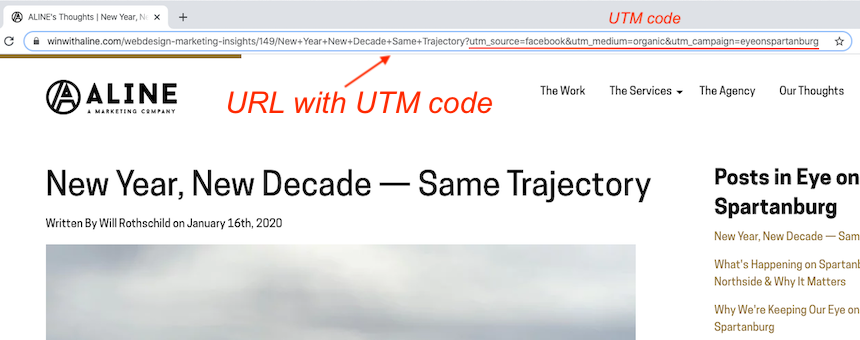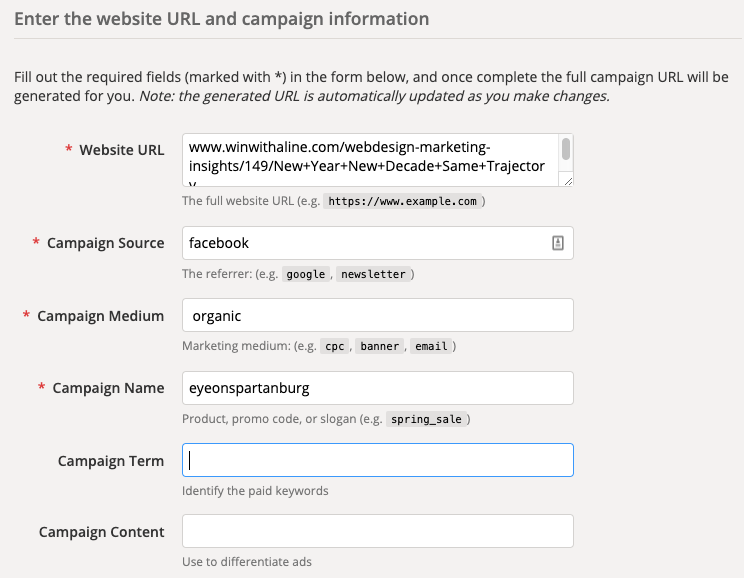Have you ever looked at the URL at the top of your browser only to see a long string of letters and symbols that go on way after the website’s name? While these URLs can be bulky (especially if you try to copy and paste a website link), they have been created with great care to reveal a lot of information about you and how you ended up on that website. Those snippets of text—known as UTM codes—can be added to any website URL to effectively track, measure and understand how the webpage content is being found online and which advertising dollars are truly paying out.

What are UTM Codes?
UTM codes are small bits of descriptive text that you add to the end of a URL. They are used to track the source where a user found that page, the medium (or how they got there), and often the campaign that brought them there. One piece of content, such as a blog post, may have the same title but different UTM codes indicating where a user found the blog (e.g., a Facebook post, Google search, etc.)
UTM codes are useful to help understand not only where users are coming from, but which advertising dollars successfully brought them there. UTM codes are thus a valuable tool for website analytics.
What information can UTM codes tell you?
When used effectively and correctly, UTM codes can reveal exactly where (the source), how (the medium), and why (the campaign) a user found your website content.
The source part of a UTM code is the platform a user was on when they clicked through to your content. Sources listed in a UTM may include (and are always written in lowercase):
- google
- facebook (for example an ad OR regular organic post)
- twitter
- instagram
- linkedin
- eblast (email newsletter)
- direct (when a user directly types in a URL, often from a print piece)
The medium in a UTM code shows the channel where the visitor came from, which gives insight into the role you played in pushing that content out. Sample mediums include:
- organic (when you have posted content somewhere for free)
- cpc (cost-per-click, i.e. paid ads)
- offer
- boosted
- email (a link in an email newsletter)
The campaign in a UTM code helps you identify a specific campaign that led the user to click to the content. For example, a company may run a series of ads called “local-community” and another called “new-residents” (each designed to target different audiences), and the UTM code would be different for each campaign.
How to Write UTM Codes
The easiest way to write a code is to use a campaign builder. Google Analytics has one for free: https://ga-dev-tools.appspot.com/campaign-url-builder/.
Simply enter the URL for the page you will be promoting (which may be any page from your site, such as “Contact” or a specific blog post). Enter the source, medium and campaign name. Use only lowercase letters, even for proper names such as Facebook or Google, and do not use any spaces (use a hyphen, not an underscore, instead of a space).
Let’s do an example.
ALINE is interested in being an active, informed and optimistic part of the Spartanburg business community. So we prepared a blog about recent growth in Spartanburg and what that means for local businesses. We then posted a link to the blog on our Facebook page. We used this info to develop the UTM code:

The final result was this UTM code:
https://www.winwithaline.com/webdesign-marketing-insights/149/New+Year+New+Decade+Same+Trajectory?utm_source=facebook&utm_medium=organic&utm_campaign=eyeonspartanburg
Next, we copied and pasted this UTM code into Facebook as the post link. This way, we’ll know for sure every time that Facebook post directed someone to our “New Year, New Decade” blog.
This all sounds a bit confusing… is it worth it?
Marketing can be time-consuming and expensive. You can spend a lot of effort in a lot of different places and not be sure what worked and what didn’t. UTM codes don't capture everything, but they are one of the best ways to see where and how your content is performing so you can direct money to where it has the best ROI.
But if you don’t want to get into the weeds creating and tracking URLs and UTM codes, ALINE is happy to do this for you. We actually get really excited about this kind of data and tracking. We can set up the campaigns and report the results in ways you can understand—and that allows you to better control your marketing dollars.
Partner with ALINE
Note: This post was originally published in February 26, 2020 and was updated in October 2022 for accuracy.

 Claiborne Linvill
Claiborne Linvill

